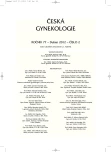Vaginal birth after previous caesarian section – outcomes analysis 2007–2010
Authors:
Lukáš Hruban 1
; Petr Janků 1
; P. Ventruba 1; L. Paúrová 1; Veronika Ťápalová 1
; A. Haraštová 1; Martin Huser 1
; Romana Gerychová 1; Z. Hodická 1; J. Jarkovský 2
Authors place of work:
Gynekologicko-porodnická klinika MU a FN Brno, přednosta prof. MUDr. P. Ventruba, DrSc.
1; Institut biostatiky a analýz MU Brno, ředitel doc. RNDr. L. Dušek
2
Published in the journal:
Ceska Gynekol 2012; 77(2): 127-132
Category:
Původní práce
Summary
Objective:
Analysis of births after previous caesarean section (SC) at Department of Obstetrics and Gynaecology, Masaryk University, Brno. Determination of successful vaginal deliveries after previous SC (complete vaginal birth) and the factors that influence success. Risk identification and determination of the frequency of complications. Comparison of vaginal births after previous SC (VBAC) with elective repeat caesarean section (ERCS).
Materials and methods:
Retrospective analysis of 24,342 births, which were conducted in 2007–2010 at Department of Obstetrics and Gynaecology, Masaryk University, Brno. For the reporting period a total of 1391 pregnant women with a history of caesarean section gave birth (100.0%). The distribution of births after previous caesarean section into 2 groups according to a method of delivery. Trying to line vaginal birth (VBAC) with 986 mothers (70.9%). Elective repeat caesarean section (ERCS) was performed in 405 mothers (29.1%). Analysis and comparison of results in both groups.
Results:
The overall success of VBAC (complete vaginal births after previous SC) in our group reached 80.8%. When evaluating the success of the subgroups was the strongest positive predictive factor the onset of spontaneous contractile activity (89.5% success rate) and vaginal delivery in history (88.2% success rate). The most significant negative predictive factor was a history of previous caesarean birth because of failure mechanism of birth (success rate 72.0%). The most common complication in both groups VBAC and ERCS group was blood loss (5.1% versus 2.0%, p = 0.045). Detection of dehiscence at the previous uterotomy (0.4% versus 0.5%, NS). In our group has been reported no case of uterine rupture. The frequency of postpartum hysterectomy was comparable in both groups (0.3% versus 0.5%, NS). In both groups, VBAC and ERCS was reported one case of bladder lesion, as surgical complications during the acute or planned caesarean section. No maternal or fetal death in relation to birth in our cohort occurred.
Conclusion:
Vaginal birth after previous caesarean section is a safe way of delivery in selected groups of mothers. An essential requirement is careful monitoring during labor to the exclusion of excessive uterine activity and protracted labor.
Key words:
caesarean section, vaginal births after previous caesarean section, VBAC, elective repeat caesarean section, ERCS, uterine rupture.
Zdroje
1. Birth after previous caesarean birth, Royal College of Obstetricians and Gynaecologists: Green-top Guideline No.45, February 2007.
2. Dodd, JM., Crowther, CA. Elective repeat caesarean section versus induction of labour for women with a previous caesarean birth. The Cochrane Library, 2009, Issue 1.
3. Guidelines for vaginal birth after previous caesarean birth. J Obstet Gynaecol Can, 2005, 27(2), p. 164–188.
4. Guise, JM., McDonagh, MS., Osterweil, P., et al. Systematic review of the incidence and consequences of uterine rupture in women with previous caesarean section. BMJ, 2004, 329, p. 19–25.
5. Induction of labor for vaginal birth aftercesarean delivery. ACOG Committee Opinion No.342. American College of Obstetricians and Gynecologists. Obstet Gynecol, 2006, 108, s. 465–467.
6. Janků, P. Použití oxytocinu v současnosti. Gyn po promoci, 2004, 4(6), p. 10–11.
7. Kennare, et al. Risks of adverse outcomes in the next birth after a first cesarean delivery. Obstet Gynecol, 2007, 109(2), p. 270–276.
8. Landon, MB., et al. Maternal and perinatal outcomes associated with a trial of labour after prior caesarean delivery. N Eng J Med, 2004, 351 (UK-NICHD study).
9. Ofir, K., Sheiner, E., Levy, A., et al. Uterine rupture: risk factors and pregnancy outcome. Am J Obstet Gynecol, 2003, 189, p. 1042–1046.
10. Ronald, S., Gibbs, et al. Danforth’s obstetrics and gynecology, X. ed. Lippincott Williams & Wilkins, 2008.
11. Silver, RM., Landon, MB., Rouse, DJ., et al. Maternal morbidity associated with multiple repeat cesarean deliveries. Obstet Gynecol, 2006, 107, p. 1226–1232.
12. Wen, SW., Rusen, ID., Walker, M., et al. Comparison of maternal mortality and morbidity between trial of labor and elective cesarean section among women with previous Cesarean delivery. Am J Obstet Gynecol, 2004, 191, p. 1263–1269.
13. Tahseen, S., Griffiths, M. Vaginal birth after two caesarean sections (VBAC-2) – a systematic review with meta-analysis of success rate and adverse outcomes of VBAC-2 versus VBAC-1 and repeat (third) caesarean sections. BJOG, 2010, 117, p. 5–19.
Štítky
Dětská gynekologie Gynekologie a porodnictví Reprodukční medicínaČlánek vyšel v časopise
Česká gynekologie

2012 Číslo 2
Nejčtenější v tomto čísle
- Triple negativní karcinom prsu – prognosticky vysoce závažná skupina mamárních malignit
- Možnosti IVF v nativním cyklu
- Uroinfekce v graviditě – kdy léčit, jak léčit a čím léčit
- Vedení porodu po předchozím císařském řezu, analýza výsledků z let 2007–2010
